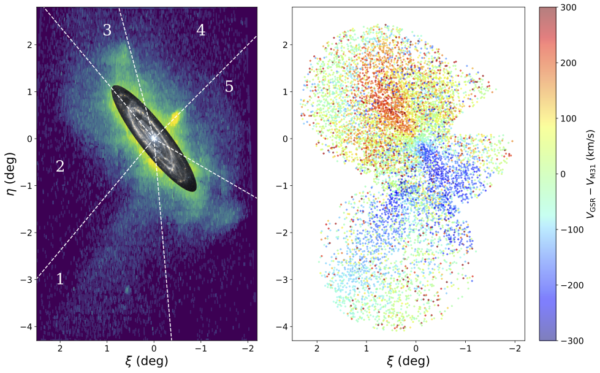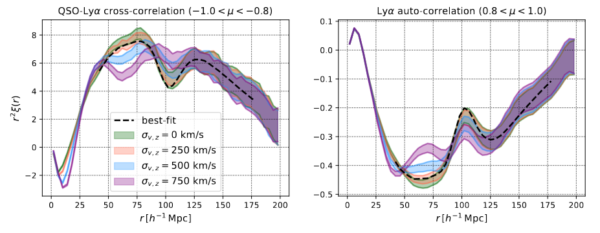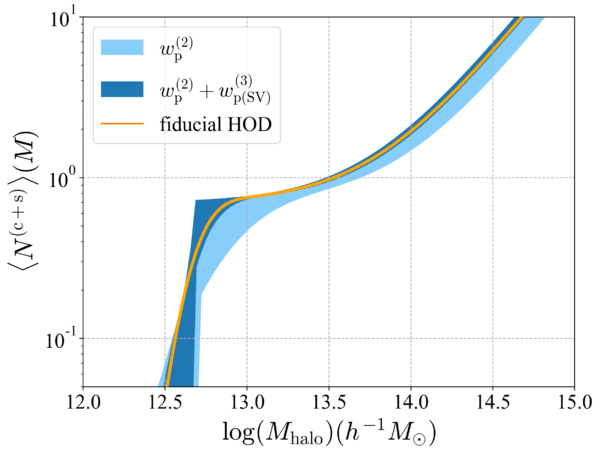DESI Observations of the Andromeda Galaxy: Revealing the Immigration History of our Nearest Neighbor
DESI is revolutionizing our ability to study the motions of individual stars in nearby galaxies. New DESI observations of the inner halo of our nearest galactic neighbor, the Andromeda Galaxy (M31), reveal evidence of a galactic immigration event in exquisite detail. Intricate structure in the positions and velocities of its stars—streams, wedges, and chevrons—indicate that a large galaxy fell into M31 a few billion years ago, launching its stars on migratory paths we can still see today. While hints of such structures have been previously detected in M31, this is the first time they have been seen with such detail and clarity in a galaxy beyond our own Milky Way. The emerging picture of M31 is similar to that of our own galaxy, whose inner halo is also dominated by a single immigration event, but one that began about 8 to 10 billion years ago. As a result, our current view of M31 may open a window onto our past, a look at what our own galaxy looked like billions of years ago.

Intrinsic Alignment as an RSD Contaminant in the DESI Survey
 DESI is slightly more likely to observe elliptical galaxies with are “pointed” at us, because their light is more concentrated on the sky than ones which aren’t. The orientations of galaxies can be correlated with the underlying density of the Universe, so if there is a bias in the orientation of galaxies that DESI observes, there will also be a bias in DESI’s measurements of the underlying density. We measure and model these two effects, then predict how they will impact DESI’s measurements of Redshift Space Distortions. See here for an accessible summary of this paper.
DESI is slightly more likely to observe elliptical galaxies with are “pointed” at us, because their light is more concentrated on the sky than ones which aren’t. The orientations of galaxies can be correlated with the underlying density of the Universe, so if there is a bias in the orientation of galaxies that DESI observes, there will also be a bias in DESI’s measurements of the underlying density. We measure and model these two effects, then predict how they will impact DESI’s measurements of Redshift Space Distortions. See here for an accessible summary of this paper.
The effect of quasar redshift errors on Lyman-α forest correlation functions
 We study the impact of errors in estimates of quasar redshift on the BAO parameters measured by Lyman-alpha correlation functions. While changes to the BAO peak position are negligible, a significant unphysical correlation along the line-of-sight is induced by the errors. We derive a simple model to describe this contamination in the Lyman-alpha—quasar cross-correlation, which will be used to improve fitting in BAO analyses.
We study the impact of errors in estimates of quasar redshift on the BAO parameters measured by Lyman-alpha correlation functions. While changes to the BAO peak position are negligible, a significant unphysical correlation along the line-of-sight is induced by the errors. We derive a simple model to describe this contamination in the Lyman-alpha—quasar cross-correlation, which will be used to improve fitting in BAO analyses.
Constraining galaxy—halo connection with high-order statistics
 We use the tabulation method to investigate using three-point statistics to constrain the galaxy—halo connection. We test our method on the galaxies designed to emulate the Luminous Red Galaxies (LRGs), Emission Line Galaxies (ELGs), and Quasars (QSOs) targeted by DESI. We show that for some LRG samples, the constraints on the halo occupation distribution parameters are dominated by the three-point function signal (over its two-point counterpart).
We use the tabulation method to investigate using three-point statistics to constrain the galaxy—halo connection. We test our method on the galaxies designed to emulate the Luminous Red Galaxies (LRGs), Emission Line Galaxies (ELGs), and Quasars (QSOs) targeted by DESI. We show that for some LRG samples, the constraints on the halo occupation distribution parameters are dominated by the three-point function signal (over its two-point counterpart).